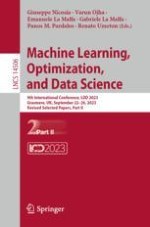2024 | Buch
Machine Learning, Optimization, and Data Science
9th International Conference, LOD 2023, Grasmere, UK, September 22–26, 2023, Revised Selected Papers, Part II
herausgegeben von: Giuseppe Nicosia, Varun Ojha, Emanuele La Malfa, Gabriele La Malfa, Panos M. Pardalos, Renato Umeton
Verlag: Springer Nature Switzerland
Buchreihe : Lecture Notes in Computer Science
